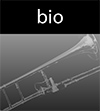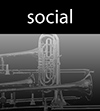Tuba and Trombones at rest on rehearsal break between Bartok and Tchaikovsky. (left to right) 1920's Holton BBb Tuba, Edwards B502-I Bass Trombone, Edwards T396-A with black valve cap, Edwards T350HB.
Miraculous Mandarin
Bartok's "Miraculous Mandarin" is a favorite for the trombone section. The original ballet is compelling and visceral. Indeed, it was banned on moral grounds when premiered in Cologne, Germany in 1926. Still somewhat controversial, it depicts 3 roommates, two guys and a girl, who need money for rent. So, they decide to entice men to their apartment through a seductive window dance by the girl. When potential "Johns" ascend for business the two remaining roommates proceed to mug them and toss them down the stairs. This process is repeated two times before we actually meet the Mandarin himself.
Throughout the ballet you can hear programmatic elements. The kaleidoscopic city noises in the strings and wood winds in the beginning lurch the piece forward. Above it all is Jim Markey's fantastic bass trombone solo to portray odd rhythmic car horn noises. As we descend on the scene of the three conspirators, the piece rapidly changes mood to show heated arguments, lurid seductive dancing, and physical violence with obvious 20th century compositional style. There is a bite in the articulation that I can hear clearly from my colleagues in all sections as a crucial element of many phrases. The wide color range helps bring the absent dance choreography into focus to demonstrate everything from vividly lewd sexual dancing to potential "Johns" being tossed down the stairs with rapid and articulative descending chromatic scales.
I love performing music like this that is so viscerally expressive and raw. I don't know if it is because we trombones have slides or because we sound frightening at fortissimo with straight mutes, but with controversial subjects such as murder, mugging, and sex, the trombone section always seem to get dirty up to their elbows with the expressive phrasing at the center of the controversy. I myself got to play a solo with several lewd upward glissandos that portrayed an old man with feeble seductive skills.
The famous Mandarin chase scene is where Steve Lange and I get to pass a rapid rhythmic solo pentatonic melody between us. This is a popular orchestral audition excerpt for section playing because of the need to seamlessly match 1st and 2nd trombone parts at breakneck speed. Usually when any trombone player gets to play the Mandarin chase in an audition they are quite close to winning a job that will signify a MAJOR life change.
Nelsons required an intense volume and vigor in the chase. "Like a Ferrari" he said "that might just take off and leave the orchestra behind!" Although it was muted it was intensely loud with compact articulation and it was extremely exciting to play. I am reminded that after living these great works as a performer it is actually very difficult for me sit still through a concert of somebody else performing. When everyone gets a bite and potential snarl in the sound at the very end it is a huge relief to stand for how excited my whole body is with the music.
Mike Roylance poses midweek with the two tubas he tried out for Tchaikovsky No. 6. (Left to Right) Nirschl 6/4 CC and 1920's era Holton BBb.
Tchaikovsky No. 6
Never does a year go by that I don't get to enjoy Tchaikovsky Symphony No. 6 with the Boston Symphony at least once. As with all pieces, the brass section works hard to build on all previous performances we have had. We do our best to bring our phrase goals and dynamic balance even more in focus each time we play. The low brass in particular has several moments to shine with loud and soft playing in all movements.
I generally don't look forward as much to the 3rd movement for how consistently bombastic and rather "affected" Tchaikovsky required the volume of the brass fanfares to be. Indeed, we have more than an entire page of fortissimo to quadruple forte to play. Nelsons really helped us to pace it well to be very artistically satisfying. Rather than keep it a fanfare throughout, he asked us specifically to play some sections less loud, and for running eighth notes to play short and bright as if to show that Tchaikovsky was intensely afraid of mice! With great works such as this I always become aware of new things no matter how many times we perform them. For the third movement especially, I was transfixed by the running sextuplets in the strings throughout. I was newly aware for this movement that I was a part of watch with parts moving so fast underneath that one could barely see them. And yet everything was so beautifully precise that all you can see is perfect phrase beauty at every level whether phrases were moving fast or broadly.
I must say that for all of Andris Nelsons' concerts this season, there has been tremendous audience decorum. I never heard a cell phone go off during pregnant pauses or even coughing for that matter. It is as if we were all participating in the magic on the same team. Of course, however, no audience can ever resist thunderous applause after the 3rd movement. ;-)
The somber 4th movement is extremely gratifying. Since this is his last symphony, I feel like the entire movement is the summation of a gentleman's death bed conversations. As he speaks with those closest to him about his life there is sentimental drama sadness remorse. The chorale for the low brass at the end of the 4th movement is very dear to me. As a programmatic element for the last words a dying man, I feel like the chorale is the low brass section depicts him saying, "I am filled with regret for so many things of my life, but I am so grateful that I loved you . . . "









